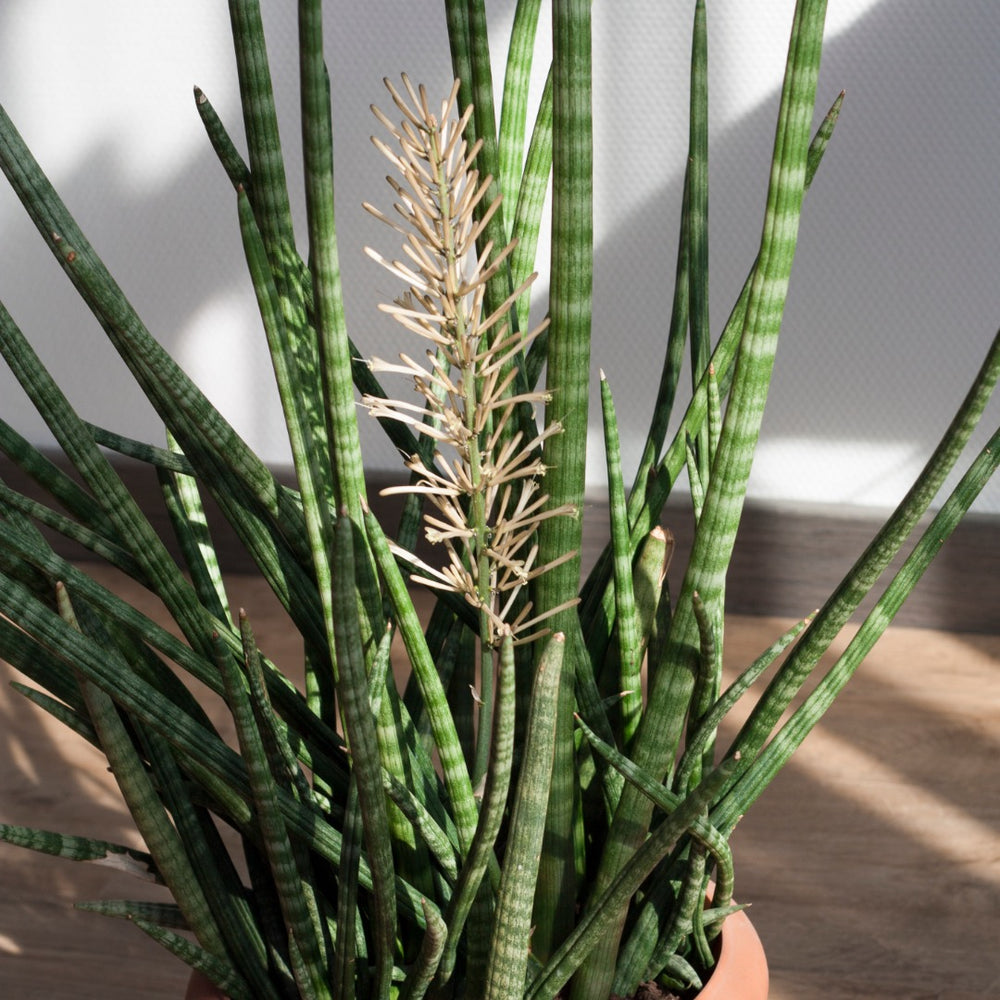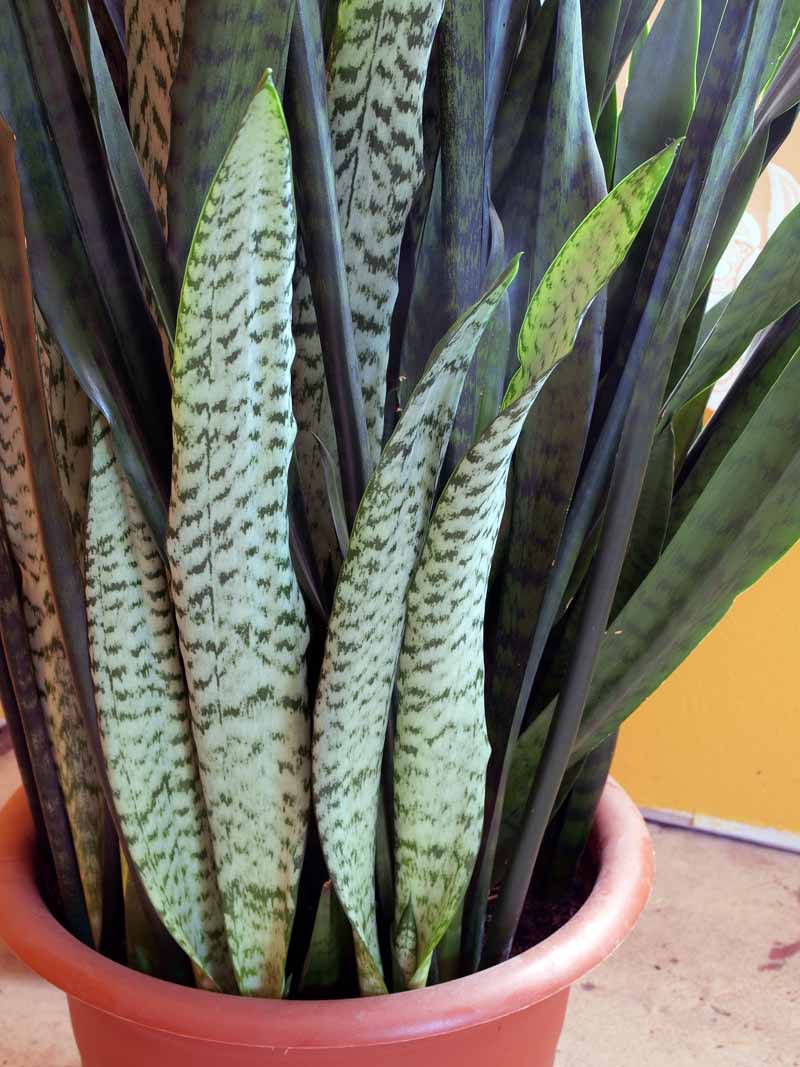Understanding the Biology of Snake Plants
Snake plants, also known as Sansevieria Trifasciata, are popular houseplants native to West Africa. They are known for their ability to thrive in a variety of environments, making them a great choice for indoor spaces. But have you ever wondered how big can a snake plant get? To understand the growth potential of these plants, it’s essential to delve into their biology.
Snake plants are perennial plants that belong to the Asparagaceae family. They have a unique growth habit, characterized by long, sword-shaped leaves that can grow upright or horizontally. The leaves are typically a deep green color with yellow or white edges, and can grow up to 4 feet long in ideal conditions.
In their natural habitat, snake plants grow in well-draining soil and full sun to partial shade. They are adapted to survive in dry conditions, making them drought-tolerant. However, they will still require regular watering to thrive. Understanding these basic biological characteristics is crucial in providing the right environment for your snake plant to grow.
By replicating the conditions found in their natural habitat, you can encourage your snake plant to reach its full growth potential. This includes providing bright, indirect light, and maintaining a consistent temperature between 65-75°F (18-24°C). With proper care, snake plants can grow up to 3-4 feet tall, making them a stunning addition to any room.
While the maximum height of a snake plant can vary depending on the variety, most plants can grow up to 2-3 feet tall with proper care. However, some varieties, such as the Sansevieria Trifasciata ‘Laurentii’, can grow up to 4 feet tall. By understanding the biology of snake plants, you can provide the right conditions to encourage healthy growth and maximize their height.
Factors Affecting Snake Plant Growth: Lighting, Watering, and Humidity
When it comes to growing snake plants, several factors can impact their growth and overall health. Lighting, watering, and humidity are three of the most critical factors that can affect how big can a snake plant get. By understanding how these factors impact snake plant growth, you can optimize their conditions to promote healthy growth.
Lighting is one of the most critical factors affecting snake plant growth. Snake plants can thrive in a variety of lighting conditions, from bright indirect light to low light. However, they will grow best in bright, indirect light. Placing your snake plant near an east- or west-facing window is ideal, as it will provide the right amount of light for optimal growth.
Watering is another crucial factor that can impact snake plant growth. Snake plants are drought-tolerant, but they will still require regular watering to thrive. Overwatering can be detrimental to snake plant growth, as it can cause root rot and other problems. Water your snake plant sparingly, allowing the soil to dry out between waterings.
Humidity is also an important factor to consider when growing snake plants. Snake plants prefer a relatively low humidity environment, around 40-50%. However, they can adapt to average humidity levels found in most homes. To promote healthy growth, you can place your snake plant on a tray filled with water and pebbles to increase the surrounding humidity.
By optimizing these factors, you can create an ideal environment for your snake plant to grow. Remember, the key to promoting healthy growth is to provide the right conditions for your snake plant to thrive. By doing so, you can help your snake plant reach its full growth potential and answer the question of how big can a snake plant get.
https://www.youtube.com/watch?v=dcTuqj3F2Lo
How to Provide the Right Environment for Your Snake Plant to Thrive
Creating an ideal environment for your snake plant is crucial for maximizing its growth potential. By providing the right conditions, you can help your snake plant grow tall and healthy, answering the question of how big can a snake plant get. In this section, we will discuss the importance of potting mix, fertilization, and pruning in creating an optimal environment for your snake plant.
Potting mix is a critical factor in snake plant growth. A well-draining potting mix is essential to prevent waterlogged soil, which can lead to root rot and other problems. Look for a potting mix that is specifically designed for cacti and succulents, as these mixes tend to be more draining than regular potting soil.
Fertilization is also important for snake plant growth. Feed your snake plant with a balanced, water-soluble fertilizer during the growing season (spring and summer). Dilute the fertilizer to half the recommended strength to prevent burning the roots. Avoid fertilizing during the winter months when the plant is dormant.
Pruning is another important aspect of snake plant care. Prune your snake plant regularly to maintain its shape and promote healthy growth. Remove any dead or damaged leaves, and cut back overgrown leaves to encourage new growth. Pruning also helps to prevent the plant from becoming too leggy and promotes a fuller, more compact growth habit.
By providing the right potting mix, fertilization, and pruning, you can create an ideal environment for your snake plant to thrive. Remember, the key to maximizing snake plant growth is to provide the right conditions for the plant to grow. By doing so, you can help your snake plant reach its full growth potential and enjoy its beautiful, upright foliage.
The Role of Pot Size and Repotting in Snake Plant Growth
Pot size and repotting play a crucial role in snake plant growth. A pot that is too small can limit the plant’s growth, while a pot that is too large can cause the soil to become too wet. Choosing the right pot size and repotting your snake plant at the right time can help promote healthy growth and maximize its potential.
When choosing a pot for your snake plant, consider the plant’s mature size. A general rule of thumb is to choose a pot that is only 1-2 sizes larger than the plant’s current pot. This will give the roots enough room to grow without becoming too wet. For example, if your snake plant is currently in a 6-inch pot, you can repot it into an 8-10 inch pot.
Repotting your snake plant is also important for promoting healthy growth. Snake plants typically need to be repotted every 2-3 years, as their roots can become pot-bound. Repotting your snake plant in the spring or summer when it is actively growing can help promote new growth and maximize its potential.
When repotting your snake plant, make sure to choose a well-draining potting mix and a pot that is only slightly larger than the previous one. This will help prevent the soil from becoming too wet and reduce the risk of root rot. Also, make sure to handle the roots gently and avoid damaging them during the repotting process.
By choosing the right pot size and repotting your snake plant at the right time, you can help promote healthy growth and maximize its potential. Remember, the key to maximizing snake plant growth is to provide the right conditions for the plant to grow. By doing so, you can help your snake plant reach its full growth potential and answer the question of how big can a snake plant get.
Snake Plant Varieties: Which Ones Grow the Tallest?
There are several varieties of snake plants, each with its own unique characteristics and growth habits. Some varieties are known to grow taller than others, making them ideal for those who want to maximize the height of their snake plant. In this section, we will introduce some of the most popular snake plant varieties and their growth habits.
One of the tallest snake plant varieties is the Sansevieria Trifasciata ‘Laurentii’. This variety can grow up to 4 feet tall, making it a great choice for those who want to add a dramatic touch to their indoor space. The ‘Laurentii’ variety has yellow-edged leaves and a more compact growth habit than other varieties.
Another popular variety is the Sansevieria Cylindrica. This variety can grow up to 3 feet tall and has a unique, cylindrical shape. The leaves are a deep green color and have a waxy texture. The Sansevieria Cylindrica is a great choice for those who want a low-maintenance plant that can thrive in a variety of lighting conditions.
The Sansevieria Moonshine is a variety that is known for its striking, silvery-gray leaves. This variety can grow up to 2 feet tall and has a more compact growth habit than other varieties. The Sansevieria Moonshine is a great choice for those who want a plant that can add a touch of elegance to their indoor space.
When growing snake plants, it’s essential to provide the right conditions for optimal growth. This includes providing bright, indirect light, and maintaining a consistent temperature between 65-75°F (18-24°C). By providing the right conditions and choosing the right variety, you can help your snake plant reach its full growth potential and answer the question of how big can a snake plant get.
Common Mistakes to Avoid When Growing Snake Plants
While snake plants are known for their low-maintenance requirements, there are still some common mistakes that can limit their growth and overall health. By avoiding these mistakes, you can help your snake plant reach its full growth potential and answer the question of how big can a snake plant get.
One of the most common mistakes is overwatering. Snake plants are drought-tolerant and can survive with minimal watering. However, overwatering can cause the roots to rot, leading to a decline in plant health. To avoid overwatering, make sure to check the soil moisture before watering, and only water when the soil feels dry to the touch.
Underwatering is another common mistake that can limit snake plant growth. While snake plants can survive with minimal watering, they still need some water to thrive. To avoid underwatering, make sure to water your snake plant regularly, but avoid getting the leaves wet to prevent fungal diseases.
Inadequate light is also a common mistake that can limit snake plant growth. Snake plants prefer bright, indirect light, but can tolerate low light conditions. However, if the light is too low, the plant may not be able to photosynthesize properly, leading to a decline in growth. To avoid inadequate light, make sure to place your snake plant in a spot with bright, indirect light, or consider using grow lights to supplement the natural light.
Another common mistake is not repotting the plant often enough. Snake plants typically need to be repotted every 2-3 years, as their roots can become pot-bound. To avoid this, make sure to repot your snake plant regularly, using a well-draining potting mix and a pot that is only slightly larger than the previous one.
By avoiding these common mistakes, you can help your snake plant reach its full growth potential and thrive in its environment. Remember, the key to maximizing snake plant growth is to provide the right conditions for the plant to grow. By doing so, you can help your snake plant answer the question of how big can a snake plant get.
How to Train Your Snake Plant to Grow Upright
Training your snake plant to grow upright can be a great way to maximize its height and create a more dramatic display. By using stakes, pruning, and rotation, you can encourage your snake plant to grow upwards and reach its full potential.
One of the most effective ways to train your snake plant to grow upright is to use stakes. Simply place a stake next to the plant and gently tie the leaves to the stake using a soft material like twine or a plant tie. This will help to support the plant and encourage it to grow upwards.
Pruning is also an important part of training your snake plant to grow upright. By pruning the leaves and stems, you can encourage the plant to grow more compactly and focus its energy on growing upwards. Simply remove any dead or damaged leaves, and cut back any stems that are growing outwards.
Rotation is also a key part of training your snake plant to grow upright. By rotating the plant regularly, you can encourage it to grow more evenly and prevent it from becoming lopsided. Simply turn the plant 90 degrees every week or two to encourage even growth.
By using stakes, pruning, and rotation, you can train your snake plant to grow upright and reach its full potential. Remember, the key to maximizing snake plant growth is to provide the right conditions for the plant to grow. By doing so, you can help your snake plant answer the question of how big can a snake plant get.
It’s also important to note that training your snake plant to grow upright can take time and patience. Don’t be discouraged if your plant doesn’t respond immediately – with consistent care and attention, your snake plant should start to grow upwards and reach its full potential.
Maximizing the Height of Your Snake Plant: Tips and Tricks
By following the tips and tricks outlined in this article, you can help your snake plant reach its full growth potential and answer the question of how big can a snake plant get. Remember, the key to maximizing snake plant growth is to provide the right conditions for the plant to grow.
One of the most important things to keep in mind when growing snake plants is to provide them with bright, indirect light. This will help to promote healthy growth and encourage the plant to grow upwards. Additionally, make sure to water your snake plant sparingly, as overwatering can lead to root rot and other problems.
Another important factor to consider is the potting mix. Use a well-draining potting mix that is specifically designed for cacti and succulents. This will help to prevent waterlogged soil and root rot. Fertilization is also important, but make sure to use a balanced fertilizer that is specifically designed for indoor plants.
Pruning is also an important part of snake plant care. Prune your snake plant regularly to encourage healthy growth and prevent the plant from becoming leggy. Remove any dead or damaged leaves, and cut back any stems that are growing outwards.
Finally, don’t be afraid to experiment and try new things. Every snake plant is different, and what works for one plant may not work for another. By trying different techniques and observing the results, you can find what works best for your plant and help it reach its full growth potential.
By following these tips and tricks, you can help your snake plant grow tall and healthy, and answer the question of how big can a snake plant get. Remember to be patient, as snake plant growth can be slow, but with the right care and attention, your plant can thrive and reach its full potential.








